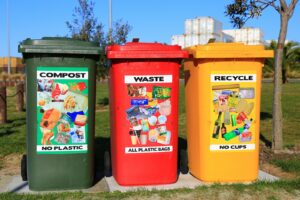 Welcome to a deep dive into the world of medical waste. If you're curious about what constitutes medical waste, the different types we encounter, and how they should be safely disposed of, you're in the right place. This article will unpack the mysteries surrounding types of medical waste, sharps disposal, and much more.
Welcome to a deep dive into the world of medical waste. If you're curious about what constitutes medical waste, the different types we encounter, and how they should be safely disposed of, you're in the right place. This article will unpack the mysteries surrounding types of medical waste, sharps disposal, and much more.
Whether you're in the healthcare industry, an environmental enthusiast, or just keen on expanding your knowledge, understanding the intricacies of medical waste is essential for promoting a safer and cleaner world.
Understanding Types of Medical Waste
When we talk about medical waste, we're referring to a variety of materials that get generated from health care activities. These can range from the obvious, like used bandages and syringes, to the less apparent, such as laboratory cultures and disposable medical tools. Generally, these wastes are categorized based on their potential risk of causing infection. The primary categories include infectious waste, hazardous chemical waste, radioactive waste, and general non-hazardous waste. Understanding these types is crucial for effectively managing and disposing of them in a manner that minimizes the risk to health care workers, patients, and the environment. By familiarizing yourself with these categories, you can develop an insight into why certain disposal methods are more stringent for some types of waste compared to others.
Navigating Regulated Medical Waste
 Regulated medical waste (RMW) requires special attention due to its potential to pose a risk to public health and safety. Examples of RMW include sharps (such as needles and scalpels), items saturated with blood or bodily fluids, microbiological wastes, and pathological wastes like human tissues and organs. The handling, storage, and disposal of RMW are governed by strict regulations to mitigate health risks.
Regulated medical waste (RMW) requires special attention due to its potential to pose a risk to public health and safety. Examples of RMW include sharps (such as needles and scalpels), items saturated with blood or bodily fluids, microbiological wastes, and pathological wastes like human tissues and organs. The handling, storage, and disposal of RMW are governed by strict regulations to mitigate health risks.
Healthcare facilities must adhere to these guidelines, which often involve using specific color-coded containers and employing licensed waste disposal firms to ensure that this type of waste is treated or destroyed in a manner that protects both healthcare workers and the public from potential exposure to infectious agents. Understanding these regulations is pivotal for maintaining a safe environment in any healthcare setting.
Blood and Blood Products: A Special Category
Blood and blood products fall into a unique category of medical waste because of their high risk of carrying bloodborne pathogens. This type of medical waste includes not only liquid waste like blood or plasma but also items that might have come into contact with blood, such as gauze, bandages, or gloves.
The disposal of blood and blood products must be handled with utmost care to prevent the spread of infectious diseases, such as HIV and Hepatitis B and C. Facilities dealing with this kind of waste typically use specially designed containers that are resistant to leakage and puncture.
Proper segregation, labeling, and the use of these specialized containment systems are key steps in ensuring the safe disposal of blood and blood products, thereby protecting healthcare workers, patients, and the community from potential health risks.
The Sharp End of Medical Waste: Sharps Explained
 Sharps medical waste encompasses any device with edges or points capable of cutting or puncturing skin. This includes needles, blades, scalpels, and even broken glass from laboratories. Due to their ability to directly transmit infectious agents by puncturing the skin, sharps are considered highly hazardous.
Sharps medical waste encompasses any device with edges or points capable of cutting or puncturing skin. This includes needles, blades, scalpels, and even broken glass from laboratories. Due to their ability to directly transmit infectious agents by puncturing the skin, sharps are considered highly hazardous.
Therefore, managing and disposing of sharps waste is critical in healthcare settings to prevent injury and the spread of infections. Facilities use puncture-resistant containers, typically colored red or yellow and marked with a biohazard symbol, to safely collect sharps.
These containers are designed to minimize the risk of needle-stick injuries among healthcare workers and are an essential part of the waste management system, emphasizing the importance of proper sharps disposal to maintain safety in medical environments.
Best Practices for Sharps Disposal
Proper disposal of sharps medical waste is not just a regulatory requirement but also a critical measure to ensure the safety of healthcare workers and patients alike. The cornerstone of safe sharps disposal involves using approved sharps disposal containers that are sturdy, leak-proof, and puncture-resistant. These containers should be easily accessible in areas where sharps are frequently used, reducing the likelihood of improper disposal. Additionally, it's crucial never to overfill these containers as this increases the risk of needle-stick injuries. Once they reach the fill line, they must be securely closed and removed according to local regulations for medical waste. By adhering to these practices, healthcare facilities can greatly reduce the hazards associated with sharps waste, protecting everyone within their environment from potential harm.
Ensuring Safe and Effective Disposal of Medical Waste
The final step in managing medical waste effectively involves adopting a comprehensive disposal strategy that adheres to both regulatory requirements and best practices for environmental protection. This includes segregating waste at the point of generation according to type to ensure that it's treated appropriately. Infectious and hazardous wastes require specialized treatment methods, such as autoclaving or incineration, to render them non-infectious before disposal.
Non-hazardous waste, while less risky, still demands proper handling to avoid adding undue stress to landfills. Healthcare facilities should partner with certified medical waste disposal companies that follow state and federal regulations closely, ensuring that waste is transported, treated, and disposed of in a manner that minimizes risk to public health and the environment. Establishing these safe and effective disposal practices is essential for maintaining a healthy community and planet.
